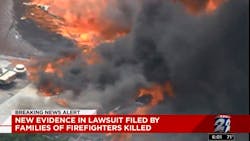New Evidence in Houston Firefighter LODDs
Evidence supporting the claims of four fallen Houston firefighters that radio problems likely contributed to their deaths was revealed this week in a lawsuit against the makers of the radios.
According to television station KPRC, a lawsuit was filed against Motorola involving the deaths of four Houston firefighters killed in a fired at the Southwest Inn on May 31, 2013. The lawsuit was filed on behalf of the families of Robert Bebee, Robert Garner, Matthew Renaud and Anne Sullivan. A fifth firefighter, Robert Yarborough, who survived the fire but suffered serious injuries also joined the suit.
HFD Captain Bill Dowling was also critically injured during the fire and eventually died as a result of those injuries in 2017. He had both of his legs amputated at the waist and suffered brain damage as a result of massive smoke inhalation that left him unable to communicate. .
Ben Hall, the attorney for the plaintiffs, released the new information on Thursday. It comes from a report by famed pathologist Dr. Michael Baden, former chief medical examiner for New York City and the former chief forensic pathologist for the New York State Police.
The television station reported that Baden’s report said the firefighters who died in the fire suffocated. He also reported the firefighters could have been successfully revived seven minute after they lost breathable air.
The lawsuit claims the faulty radios caused an 18-minute delay in firefighters reaching their trapped colleagues, according to the television station.
Specifically, Baden’s report states: “It is my opinion, to a reasonable degree of medical certainty, on the basis of my education, training and experience, and the above materials that I have reviewed, that Firefighters Bebee, Garner, Renaud and Sullivan died of suffocation after their compressed air had been depleted; that if they had been found within five to seven minutes earlier they would have successfully responded to CPR; and that the attributed causes of death are not supported by the circumstances, autopsy and toxicologic findings.”
Baden said in his report to Attorney Hall, that the official causes of death, including smoke inhalation, trauma and compression injuries were not supported by the evidence.
Motorola responded to the allegations in 2016 in a statement that read in part: “We want to reiterate our sympathy toward victims of the May 2013 tragedy and remind that an independent report after the fire listed numerous potential contributing factors. Since the fire, Motorola Solutions has worked closely with the Houston Fire Department to improve training and understanding of operational capabilities, as well as to provide system enhancements. We stand behind our equipment and support our Houston customer.”
In 2015, the National Institute for Occupational Safety and Health (NIOSH) issued a 108-page report that stated in part the roof collapsed approximately15 minutes after crews arrived on the scene,
In the 20 minutes following the collapse, radio traffic increased as crews were sent in to find the missing firefighters.
The NIOSH report stated: "At this point in the incident, radio communications were severely hampered due to significant radio traffic, which overloaded the radio system." Trouble with radio communication made rescue attempts even more difficult. The report found crews were attempting to account for every firefighter on the scene, but "due to issues with the radio system, it took the accountability officer 44 minutes to complete the PAR (personal accountability report)."
NIOSH listed eight contributing factors that lead to the firefighters’ death and injuries, including the fact the fire burned unreported for three hours; delayed notification to the fire department; building construction; wind-impacted fire; scene size-up; personnel accountability; fireground communications; and lack of a fire sprinkler system.
The lawsuit was filed in 2015 shortly after the NIOSH report was released.
